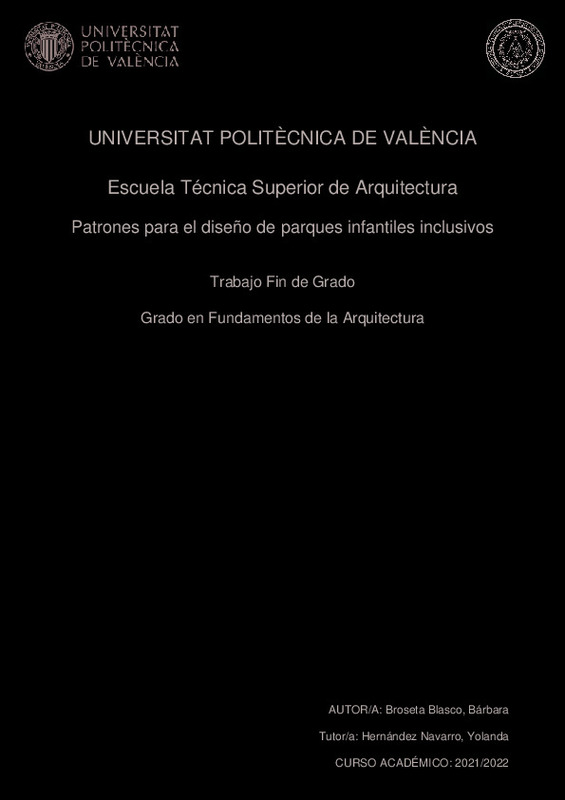JavaScript is disabled for your browser. Some features of this site may not work without it.
Buscar en RiuNet
Listar
Mi cuenta
Estadísticas
Ayuda RiuNet
Admin. UPV
Patrones para el diseño de parques infantiles inclusivos
Mostrar el registro sencillo del ítem
Ficheros en el ítem
| dc.contributor.advisor | Hernández Navarro, Yolanda
|
es_ES |
| dc.contributor.author | Broseta Blasco, Bárbara
|
es_ES |
| dc.date.accessioned | 2022-11-09T13:37:15Z | |
| dc.date.available | 2022-11-09T13:37:15Z | |
| dc.date.created | 2022-07-26 | |
| dc.date.issued | 2022-11-09 | es_ES |
| dc.identifier.uri | http://hdl.handle.net/10251/189515 | |
| dc.description.abstract | [ES] Debido a la revisión de la figura del niño del siglo XX el diseño de parques infantiles tomó protagonismo para su bienestar. Sin embargo, la evolución de los parques ha tenido en cuenta un estereotipo normalizado de niño, social, deportista y con habilidades motrices, discriminando en consecuencia al resto de niños que no entran en este perfil tipo. El grupo más afectado son los niños con dificultades motrices y sociales, puesto que no les permiten disfrutar de los parques que se ofrecen hoy en día. En especial, este trabajo está enfocado a los niños en el espectro autista y a su inclusión en estos espacios sociales de juego, puesto que todavía están excluidos de muchas maneras en la sociedad por falta de la comprensión de sus necesidades. Por lo que se seleccionan unos casos de estudio para analizarlos arquitectónicamente, de manera que se extraen unos patrones para el diseño de estos. | es_ES |
| dc.description.abstract | [EN] Due to the revision of the child figure during S.XX, the design of public playgrounds became a priority. However, the evolution of the playgrounds only considered a stereotypical kid: social, sportive and with motor skills, discriminating, in consequence, all the other kinds of children that do not entre in this profile. The most concerned group are the kids with motor and social difficulties, because they cannot enjoy the playgrounds that actually exist. Especially, this essay is focused on children with ASD and their inclusion in the public spaces, since they are still excluded in many ways from society because there is not enough understanding of their necessities. Therefore, case studies are selected to be analyse architectonically, so finally patterns can be concluded to design appropriately playgrounds. | es_ES |
| dc.format.extent | 88 | es_ES |
| dc.language | Español | es_ES |
| dc.publisher | Universitat Politècnica de València | es_ES |
| dc.rights | Reserva de todos los derechos | es_ES |
| dc.subject | Diseño | es_ES |
| dc.subject | Inclusividad | es_ES |
| dc.subject | Juego | es_ES |
| dc.subject | Infancia | es_ES |
| dc.subject | Parques | es_ES |
| dc.subject | Integración | es_ES |
| dc.subject | Design | es_ES |
| dc.subject | Inclusivity | es_ES |
| dc.subject | Play | es_ES |
| dc.subject | Childhood | es_ES |
| dc.subject | Playgrounds | es_ES |
| dc.subject | Integration | es_ES |
| dc.subject.classification | COMPOSICION ARQUITECTONICA | es_ES |
| dc.subject.other | Grado en Fundamentos de la Arquitectura-Grau en Fonaments de l'Arquitectura | es_ES |
| dc.title | Patrones para el diseño de parques infantiles inclusivos | es_ES |
| dc.title.alternative | Patterns for the design of inclusive playgrounds | es_ES |
| dc.title.alternative | Patrons per al disseny de parcs infantils inclusius | es_ES |
| dc.type | Proyecto/Trabajo fin de carrera/grado | es_ES |
| dc.rights.accessRights | Abierto | es_ES |
| dc.contributor.affiliation | Universitat Politècnica de València. Departamento de Composición Arquitectónica - Departament de Composició Arquitectònica | es_ES |
| dc.contributor.affiliation | Universitat Politècnica de València. Escuela Técnica Superior de Arquitectura - Escola Tècnica Superior d'Arquitectura | es_ES |
| dc.description.bibliographicCitation | Broseta Blasco, B. (2022). Patrones para el diseño de parques infantiles inclusivos. Universitat Politècnica de València. http://hdl.handle.net/10251/189515 | es_ES |
| dc.description.accrualMethod | TFGM | es_ES |
| dc.relation.pasarela | TFGM\138162 | es_ES |
Este ítem aparece en la(s) siguiente(s) colección(ones)
-
ETSA - Trabajos académicos [4687]
Escuela Técnica Superior de Arquitectura






